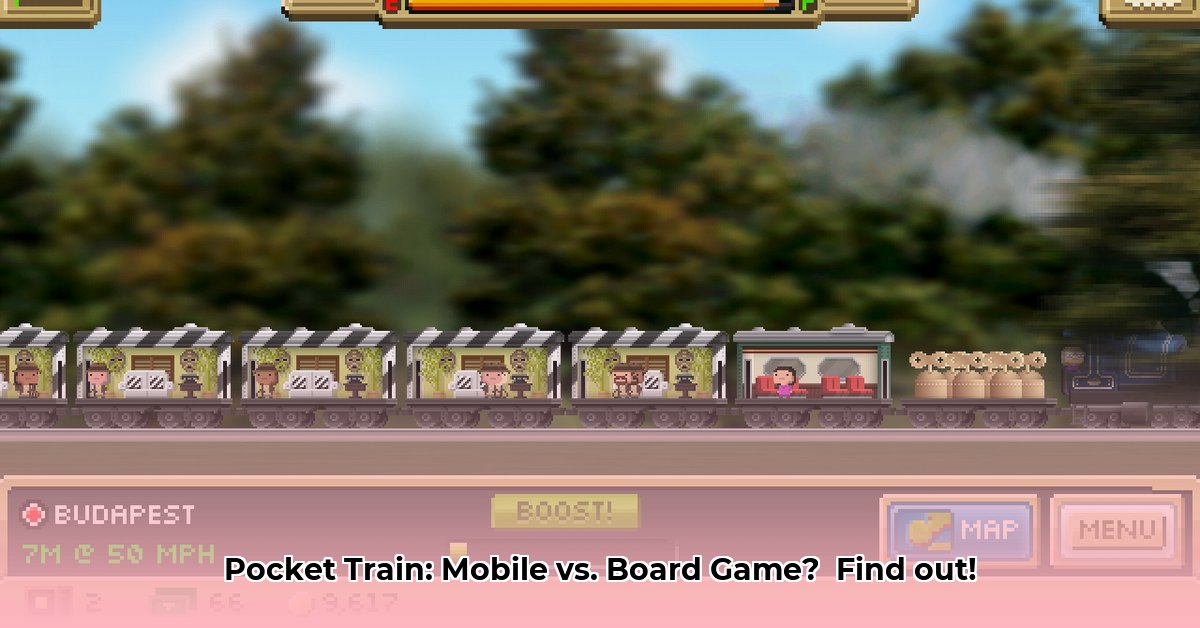
Charting Different Courses: Gameplay Differences
Both the mobile and board game versions of Pocket Trains share the core gameplay loop of building a railway empire by collecting trains, expanding your network, and managing resources. However, the experience differs significantly. The mobile app provides a largely solo, relaxing experience, perfect for brief gaming sessions. It’s designed for ease of access, letting players jump in and out quickly. In contrast, the board game is fiercely competitive, demanding longer play sessions and strategic planning against other players for control of the most profitable routes. This difference in pace and interaction shapes the vastly different player experiences.
Who's All Aboard? Target Audience
The mobile Pocket Trains game caters to casual gamers. Its intuitive touch controls and freemium model (free-to-play with optional in-app purchases) lower the barrier to entry, making it broadly accessible. The board game, however, targets experienced strategy game players. Its complex rules and longer playtime require a higher commitment. While the initial investment is a one-time purchase, mastering the game necessitates significant time and learning.
A Visual Comparison: Style and Feel
The mobile version boasts polished graphics, smooth animations, and a user-friendly interface for an engaging visual experience. The board game provides a different appeal: the tactile satisfaction of physically handling the train cars and track pieces. While the art style and components are likely well-executed, the focus shifts from digital polish to the tangible aspects of gameplay.
The Time Factor: A Major Consideration
The most prominent difference is time commitment. Mobile Pocket Trains is ideal for short bursts of gameplay, fitting seamlessly into a busy schedule. You can easily play for five minutes or an hour. The board game, however, demands a substantial time investment of several hours per session.
Feature Showdown: A Side-by-Side Comparison
| Feature | Pocket Trains (Mobile) | Pocket Train Game (Board) |
|---|---|---|
| Gameplay Style | Relaxed, incremental progress, solo play | Competitive, strategic, multiplayer |
| Player Interaction | Minimal | High, direct competition |
| Time Commitment | Short bursts, easily fits a busy schedule | Several hours per game session |
| Visual Style | Polished, animated graphics, smooth interface | Physical components, tactile game experience |
| Cost Structure | Freemium (in-app purchases available) | One-time purchase of the game |
| Difficulty | Easy to learn, gradually increasing complexity | High learning curve, complex strategies |
The Final Verdict: Which Train to Take?
The ideal Pocket Trains experience depends entirely on individual preferences. The mobile game offers a relaxed, accessible experience for short sessions, while the board game provides a challenging, strategic adventure for dedicated players. Both versions offer unique and rewarding gameplay. But which track will you choose?
How to Adapt Pocket Train Game Board Game Mechanics for a Mobile Game
Successfully adapting board games to mobile requires careful consideration. Preserving core mechanics while enhancing the experience through digital features is crucial. A well-designed UI/UX is paramount for a smooth mobile experience. Digital enhancements, such as animations and online multiplayer, can greatly enrich the gameplay. However, the complexity of the original board game is a significant factor.
From Tabletop to Touchscreen: A Pocket Trains Case Study
The core mechanics of Pocket Trains—managing trains, transporting goods, and expanding your network—translate well to mobile. The digital version efficiently represents physical components like train cars and cargo cards, streamlining the overall process. This successful adaptation demonstrates effective translation of board game mechanics.
Leveraging the Digital Medium: Enhancements and Challenges
The digital medium allows for expansive maps, automated elements, and faster game pacing. However, maintaining a well-designed UI/UX is essential to avoid frustrating players. The mobile version successfully addresses this challenge with intuitive controls and a user-friendly design.
Multiplayer and Monetization: Expanding the Experience
The mobile version adds online multiplayer, enhancing replayability and social interaction, a feature absent in the board game. The freemium model, using in-app purchases for cosmetic items and time-saving boosts, avoids disrupting gameplay balance.
The Verdict: A Successful Adaptation?
Pocket Trains serves as a prime example of a successful board game adaptation for mobile, preserving the core experience while leveraging the platform's unique capabilities to enhance gameplay. The thoughtful integration of digital features enhances the overall user experience, while the monetization model respects player experience.
⭐⭐⭐⭐☆ (4.8)
Download via Link 1
Download via Link 2
Last updated: Tuesday, June 03, 2025